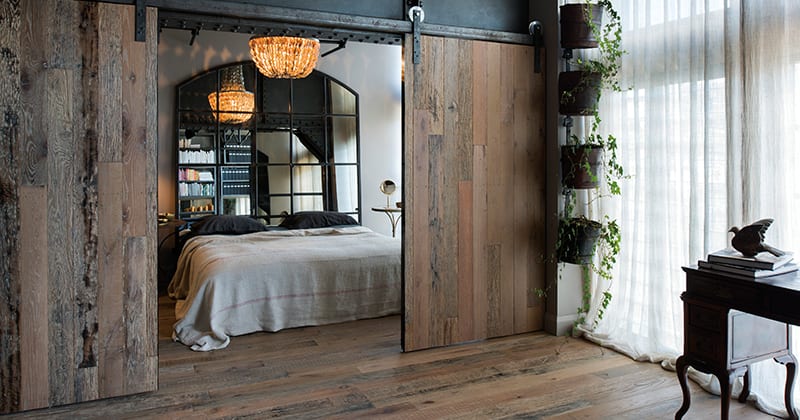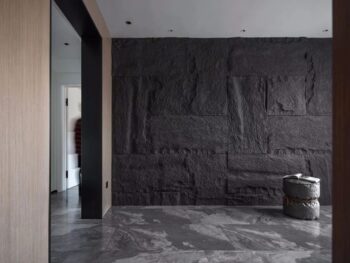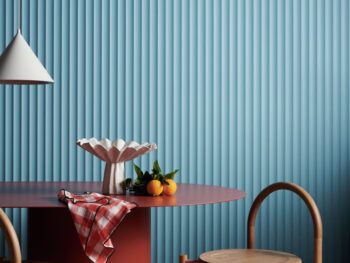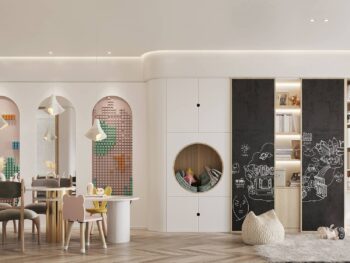
Comparison of Solid Wood Wall Panel and WPC Wall Panel
Decorating an interior space is an important decision-making process, one of which is choosing the right siding material. Solid wood siding and WPC (wood plastic composite) siding are both popular options, each with unique features and benefits. But before making a choice, it’s crucial to understand the contrast between them.
Solid wood wall panels represent tradition and natural beauty, while WPC wall panels are an advanced, environmentally friendly alternative. In this article, we’ll take a closer look at the differences between solid wood siding and WPC siding to help you make informed decisions during your renovation project.
Related Articles
Solid Wood vs MDF: Which Wall Panel Is Right for Your Home Decor?
MDF vs PVC Wall Panels: Comparison of the Differences
Choose MDF or WPC Wall Panels?
Is MDF Wall Panel or VJ Panel More Suitable for You?
I. Introduction to solid wood wall panels
Solid wood wall panel is a wall panel material used for interior decoration. It is made of solid wood, usually cut, processed and made from pieces of wood. These woods are usually from different types of trees, such as pine, oak, birch, walnut, etc., and can be selected according to decorative needs and personal taste.
Solid wood wall panels have the advantages of natural beauty, durability, environmental protection and good decorative properties. However, it should be noted that solid wood wall panels also have some potential problems, including higher price, complicated installation, easy to get damp, deformation and discoloration, etc. . Additionally, solid wood siding requires regular maintenance to maintain its beauty and performance.
Overall, solid wood wall panels are a high-quality, beautiful and environmentally friendly interior decoration material that brings natural warmth and style to a room. However, its features and suitability need to be carefully considered when selecting it to ensure it meets project needs.
II. What are the advantages and disadvantages of solid wood wall panels?
Advantages
Solid wood wall panels have many advantages that make them a popular choice for interior decoration. Here are some of the key benefits of solid wood siding:
1. Natural beauty
Solid wood siding is prized for its natural beauty. Each solid wood wall panel has a unique wood grain, color and texture, bringing a warm and natural atmosphere to the interior space.
2. High quality appearance
Solid wood wall panels provide a high-quality appearance and give interior spaces more texture and taste. They are suitable for traditional, classic and cozy decoration styles.
3. Durability
Properly maintained solid wood siding is very durable. They stand the test of time and resist scratches, scuffs and fatigue.
4. Repairability
If solid wood siding is scratched or damaged, it can usually be repaired by sanding and repainting it back to its original condition.
5. Environmentally friendly
Solid wood siding is often a sustainable choice because they use natural wood, helping to reduce the need for forest resources.
6. Hygroscopicity
Solid wood wall panels have certain hygroscopic properties, which can help regulate indoor humidity and increase comfort in dry environments.
7. Appreciation potential
Installing solid wood siding can increase the value of your home as they are considered a high-end and high-quality finishing option.
8. Customizability
Solid wood wall panels can be easily customized into a variety of shapes and designs to suit specific decorative needs.
9. Sound absorption performance
Solid wood wall panels have sound-absorbing properties to a certain extent, which can reduce indoor noise transmission and provide a quieter environment.
10. Enhance temperature stability
Solid wood wall panels are relatively insusceptible to moisture or temperature changes, and do not expand or contract easily.
Overall, solid wood wall panels stand out for their natural beauty, high-quality appearance, and durability, making them suitable for a variety of decorating projects and decorating styles. Whether in the living room, bedroom, dining room or other indoor areas, solid wood wall panels can enhance the texture and taste of the space.
Disadvantages
Although solid wood siding offers many advantages, there are also some disadvantages and limitations that need to be considered when choosing. Here are some of the main disadvantages of solid wood siding:
1. High cost
Solid wood siding generally costs more because they are made from natural wood, and different types of wood have different prices. This may make solid wood siding unsuitable for renovation projects with a limited budget.
2. Requires regular maintenance
Solid wood siding requires regular maintenance, including painting, cleaning and maintenance, to maintain its appearance and durability. If not properly maintained, wood can become dull or damaged.
3. Affected by the environment
Solid wood siding is very sensitive to environmental conditions. Moist conditions can cause wood to swell, warp, or develop mold. Therefore, it is not suitable to use solid wood wall panels in wet areas such as bathrooms or kitchens.
4. Vulnerable to physical damage
Although solid wood siding is relatively strong, it is still susceptible to physical damage such as scratches, dents, and impacts. This may require additional repairs and maintenance.
5. Limited customizability
Solid wood wall panel designs are limited by the limitations of natural wood, so highly customized designs may not be possible in some cases.
6. Sustainability issues
The use of solid wood wall panels can raise sustainability issues because they rely on limited forest resources. Ensuring that you choose a wood supplier that comes from sustainably managed sources can mitigate this problem.
7. Discoloration problem
Solid wood siding may change color over time, depending on the wood species and degree of exposure to sunlight. This can lead to an uneven appearance.
8. Installation requirements
Installing solid wood siding can require more skill and time, especially when working with different wood textures and joints.
While solid wood siding offers unique beauty and durability, these advantages and disadvantages need to be weighed when selecting to ensure they are suitable for the specific renovation project and environmental conditions.

III. Introduction to WPC wall panels
WPC wood plastic wall panel is a new ideal environmentally friendly building material choice. WPC wall panels are made of recycled plastic, wood powder, foaming agent and other additives, and bamboo fiber. After high temperature and high pressure, it can be used in pallets, packaging boards, door and window frames, decorative boards, etc.
WPC wall panel is a completely renewable material with the advantages of high density, high stability and insulation. The density of wood-plastic composite materials exceeds 1100kg/m3, which is much higher than most hardwoods. High density ensures high stability without problems such as protrusions, mold, bending, and cracking. Wood-plastic wall panels can give a building a completely new look. It is corrosion-resistant and will not fade when used outdoors for a long time.
WPC wall panels are renewable, easy to clean and low maintenance. The product complies with the concept of sustainable development, is reusable and simple to maintain, it is a very environmentally friendly building material, and the lightweight material can make your construction project easier. George Panel’s WPC wood plastic wall panels are easy to transport and install, saw, planed and drilled to present a variety of elegant designs and patterns.
Our WPC wood plastic wall panels can be used in commercial projects or residential use and are ideal for decorating or renovating building walls. As an alternative to traditional wooden boards. Our unique manufacturing process combines wood and recycled plastic. Wood-plastic siding combines the traditional look of wood with the durability of composite materials.
Whether in new construction or renovation projects, using wood-plastic panel exterior walls can give the building a completely new look. WPC wall panel has always stood out, it must be of very high-end quality. WPC is a more ideal wall panel material than metal, glass, stone, and PVC. WPC wood plastic wall panels do not require painting or other treatments, saving you time and money.
IV. What are the advantages and disadvantages of WPC wall panels?
Advantages
WPC (Wood Plastic Composite) wall panels offer a variety of benefits that make them a popular choice for interior and exterior decoration. Here are some of the main benefits of WPC wall panels:
1. Environmentally friendly
WPC wall panels are composed of recycled wood fibers and plastics, reducing the need for natural wood. This makes it a relatively environmentally friendly decorative material, helping to reduce deforestation and the generation of plastic waste.
2. Durability
WPC wall panels combine the advantages of wood and plastic and have high durability. They are not susceptible to rot, deformation, cracking or moisture and are suitable for use in a variety of climate conditions and environments.
3. Anti-fading
WPC wall panels are usually specially treated to have good fade resistance and can maintain bright colors for a long time.
4. Easy to maintain
WPC wall panels require less maintenance than solid wood wall panels. They don’t require regular paint or sealing wax, just regular cleaning.
5. Insect resistance
Because WPC siding does not contain natural wood fibers, they are more resistant to termites and other pests.
6. Diversity
WPC wall panels are available in a variety of colors, textures and surface treatment options, making them suitable for a variety of decorating styles and design needs.
7. Easy to install
WPC wall panels are generally lighter and easier to install. They can be joined by tongue and groove or cut and machined using common woodworking tools.
8. Sound absorption performance
WPC wall panels have certain sound-absorbing properties, which help reduce indoor noise transmission and provide a quieter environment.
9. Anti-slip performance
In outdoor environments, WPC wall panels often have good anti-slip properties and can provide safer walkways and floors.
10. Customizability
WPC wall panels can be cut and customized as needed to meet specific design requirements.
In general, WPC wall panels combine the advantages of wood and plastic, and are environmentally friendly, durable, easy to maintain, diverse and multifunctional. They are suitable for both indoor and outdoor decorating projects and are a popular choice of decorative material.
Disadvantages
Although WPC (wood plastic composite) wall panels have many advantages, there are also some disadvantages and limitations that need to be considered when selecting and using them. Here are some of the major disadvantages of WPC wall panels:
1. The price is relatively high
While WPC wall panels can be considered an environmentally friendly alternative, they can be more expensive than some traditional decking materials.
2. Plastic ingredients
WPC siding contains plastic components, which means chemicals are used during manufacturing and processing. Although they are generally designed not to release harmful gases, in some cases, they may cause some environmental and health problems.
3. Not suitable for extreme temperatures
When exposed to extreme heat or cold conditions for extended periods of time, WPC wall panels may become brittle, crack, or warp. Therefore, outdoor use in areas with extreme climates may require special considerations.
4. Limited natural beauty
While WPC siding can mimic the look of wood, they lack the grain and texture of real wood. For those looking for a natural beauty, this may not be the best option.
5. Difficult to repair
Unlike solid wood siding, WPC siding is often difficult to repair. Once there is severe physical damage, repair may require replacing the entire panel.
6. There is a color difference problem
Some low-quality WPC wall panels may have color variation issues, resulting in an uneven surface. Choosing high-quality WPC products can alleviate this problem.
7. Limit decorative styles
Although WPC wall panels offer certain design options, they may not be suitable for certain highly customized or complex decorative styles.
8. Limited Renewability
While WPC materials reduce the need for natural wood, they are not inherently renewable. Therefore, when choosing WPC wall panels, you need to ensure that they come from a sustainable and environmentally friendly production process.
In summary, WPC wall panels have many advantages, but there are also some potential disadvantages. When selecting and using, trade-offs and considerations need to be made based on specific decorative needs, environmental conditions and personal preferences. High-quality WPC wall panels can often mitigate some potential disadvantages.

V. Comparison of the differences between solid wood wall panels and WPC wall panels
When decorating your interior walls, you may be faced with the decision between solid wood siding or WPC (wood plastic composite) siding. Both types of decorative materials have their own characteristics, with different advantages and disadvantages. Before you make your decision, let’s delve into the differences between solid wood siding and WPC siding to help you better understand which material is best for your renovation project.
Items |
Solid Wood Wall Panel |
WPC Wall Panel |
Material |
Solid wood siding is made from natural wood, usually solid wood planks from various tree species. This gives each solid wood wall panel a unique wood grain and color, providing a natural beauty and warmth. | WPC wall panel is a composite material made from a mixture of wood fibers, plastics and other additives. They mimic the look of wood but are usually more uniform in color and texture. |
Environmental |
Solid wood siding has some sustainability limitations due to the use of natural wood. They require cutting down trees and may put some pressure on forest resources. | WPC wall panels are considered more environmentally friendly because they reduce the need for natural wood and use recycled wood fibers and plastics. This helps reduce deforestation and the amount of plastic waste. |
Durability |
Solid wood siding is very durable with proper maintenance, but requires regular painting and maintenance to maintain its appearance and performance. | WPC wall panels combine the advantages of wood and plastic and have high durability. They are not susceptible to rot, deformation or moisture, and do not require regular maintenance. |
Beauty |
Solid wood wall panels are prized for their unique wood grains, colors and textures, providing a high-quality look that works well with traditional, classic and warm decorating styles. | WPC siding can mimic the look of wood but lacks the grain and texture of real wood. They are generally more suitable for modern and versatile designs. |
Price |
Solid wood siding generally costs more because they are made from natural wood, and different types of wood have different prices. | WPC siding is generally relatively affordable and is a more cost-effective decorative option. |
Customizability |
Solid wood wall panels offer some customization, but are limited by the limitations of natural wood. | WPC wall panels are generally easier to customize and can meet various design needs because they are moldable. |
Installation Difficulty |
Installing solid wood siding can require more skill and time, especially when working with different wood textures and joints. | WPC wall panels are generally lighter and easier to install. They can be joined by tongue and groove or cut and machined using common woodworking tools. |
VI. Conclusion
The final choice will depend on your personal preferences, renovation goals, budget and environmental conditions. If you value traditional beauty and natural textures and are willing to pay for the extra maintenance, solid wood siding may be a better choice for you. And if you pay more attention to environmental protection, durability and economy, then WPC wall panels may be more suitable for your needs.
No matter which siding material you choose, be sure to choose a high-quality product and install and maintain it according to the manufacturer’s recommendations to ensure the best results for your renovation project. Ultimately, this decision will add unique style and comfort to your interior space. If you have other ideas and questions to consult, please feel free to contact us!
Quick Quotation



